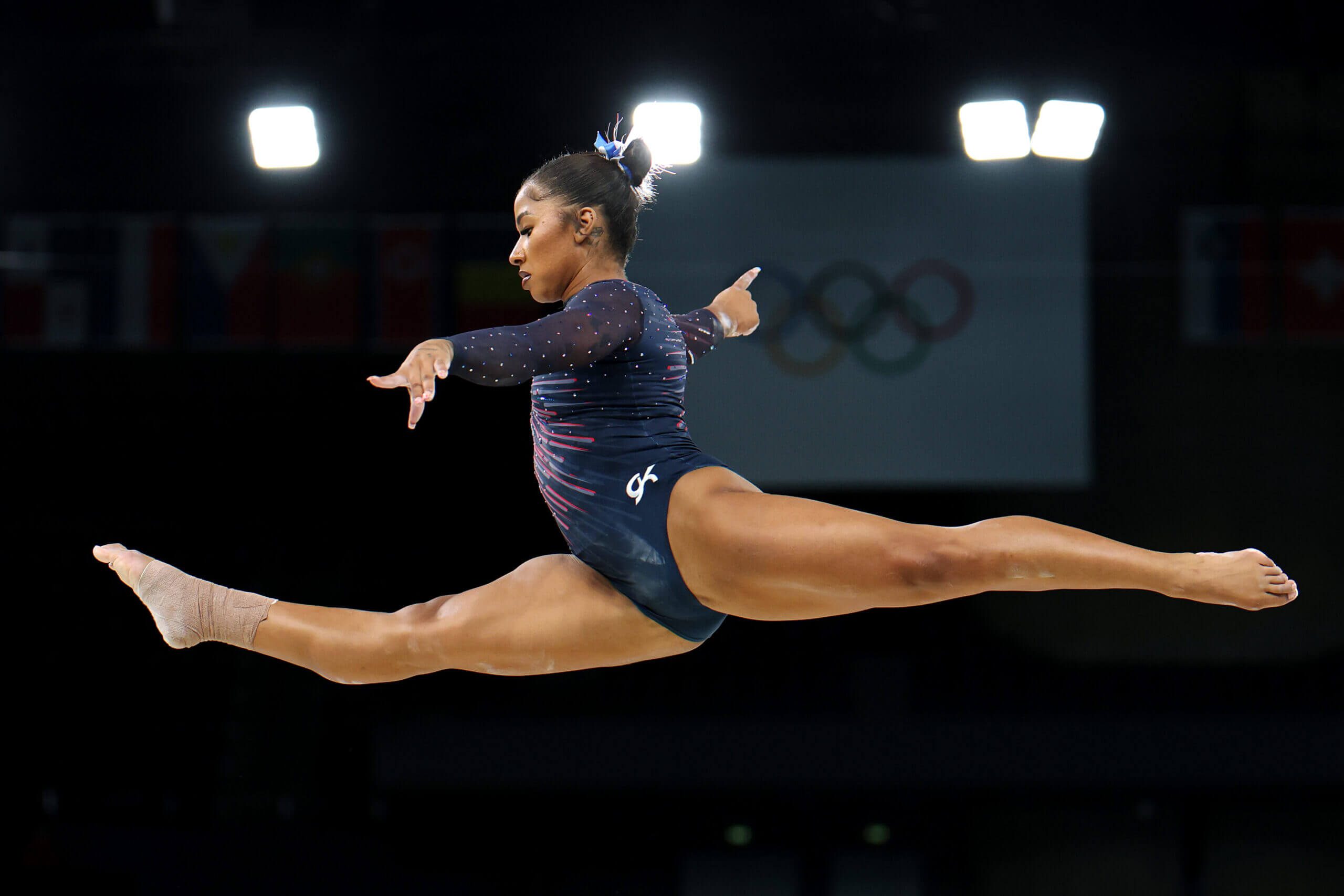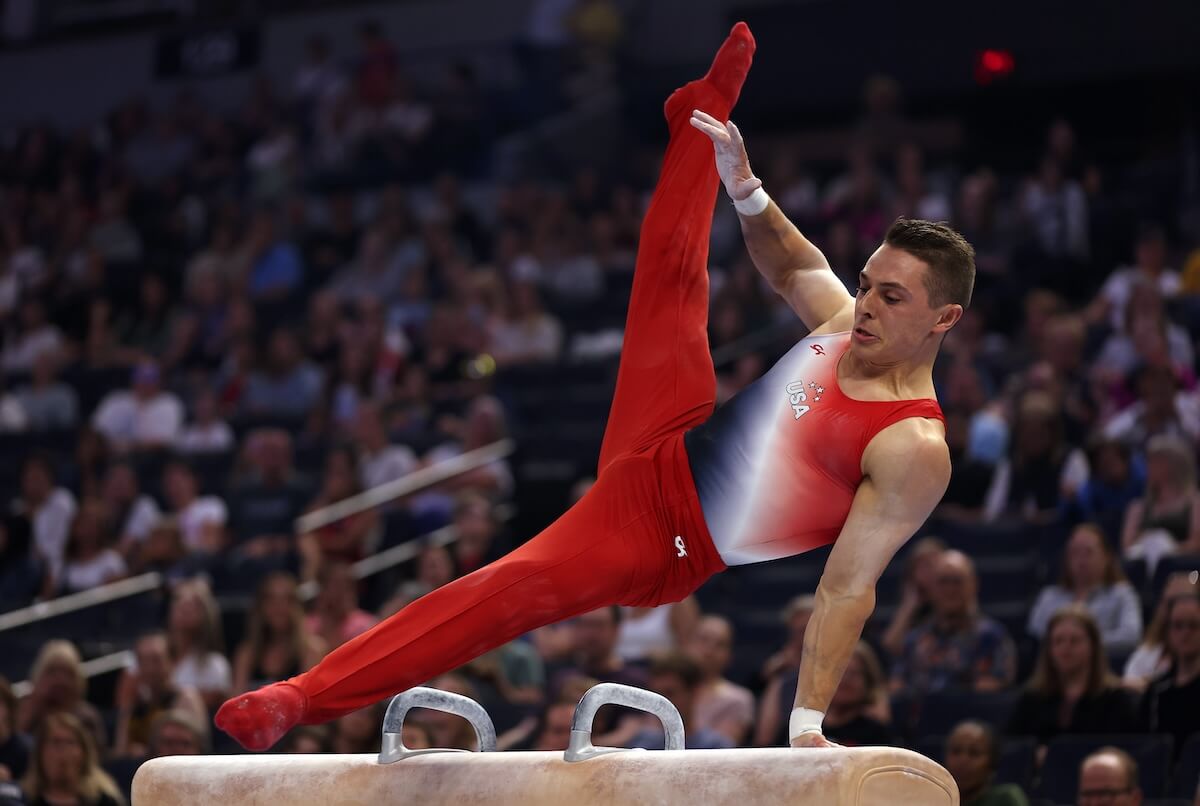
Follow our Olympics coverage from the Paris Games.
For the next two weeks, there will be talk of tumbles, twists, leaps and landings.
You’ll hear plenty about difficulty scores and rotations. But how does it all work?
The artistic gymnastics competitions at the Paris Olympics begin with men’s qualifying Saturday — the start of a busy 10 days. Whether you’re tuning into a gymnastics meet for the first time since Tokyo or just looking to brush up on old knowledge before making medal predictions, The Athletic has you covered with answers to your questions about scoring and schedule.
How does scoring work?
Each score is a sum of two separate components: the execution score (E-score) and the difficulty score (D-score). The E-score begins at a 10.0 for each gymnast and decreases throughout the routine as judges spot deductions. Slight flaws, like a step out of bounds or a small hop on a landing, may draw a deduction of 0.1, but a fall will result in an entire point knocked off an athlete’s E-score. The closer an athlete’s performance is to perfection, the higher the E-score will be.
The D-score has no maximum value. The harder a gymnast’s routine, the higher his or her difficulty score. A gymnast begins each routine with an intended D-score, but the athlete may not earn that full value if he or she doesn’t execute all planned skills or gets a skill downgraded for not performing it to the standard described in the Code of Points.
At the elite level, most D-scores fall in the 5-7 point range. An E-score around an 8.00 is good while an E-score of 9.00 or higher is excellent. Scores on vault tend to be higher than other events. A score that is 15.000 or higher is exceptional.
Simone Biles’ high scores are the result of her performing incredibly difficult skills with very few form breaks. She’s not just throwing hard tumbling passes with the hope of racking up difficulty points; she’s doing those passes cleanly and with controlled landings. (Mostly. The deduction she incurs most consistently is bouncing out of bounds for having too much power.)
At the U.S. Championships in June, Biles had a 7.0 difficulty score on floor and received an 8.200 for her execution, meaning her final score was a 15.2o0.

GO DEEPER
The story in Simone Biles’ new floor routine: The ‘big boss of gymnastics’ is back
What is the order of events?
The Olympic order of events in women’s artistic gymnastics is vault, uneven bars, balance beam, floor exercise. Gymnasts will always rotate through the events in this order even if they don’t begin competition on vault. During the qualification round of competition in Paris, the U.S. women’s team begins on beam, which means their second event will be floor. The team will then move to vault before finishing on bars.
In men’s artistic gymnastics, the Olympic order is floor exercise, pommel horse, still rings, vault, parallel bars and horizontal bar (also known as high bar). The U.S. men’s team begins qualifications on pommel horse.

Paul Juda competes on pommel horse at U.S. Olympic trials. (Jamie Squire / Getty Images)
What is the format of the competition?
The first day of competition is the qualification round. No medals are awarded, but gymnasts’ performances on this day dictate the rest of their Olympic schedules. Qualifications will feature 12 teams and mixed groups of individual athletes from nations that didn’t qualify full squads to the 2024 Games. These teams and individuals are spread across multiple subdivisions (three subdivisions in the men’s competition and five subdivisions in the women’s).
Qualifications use a “four up, three count” format, which means four gymnasts compete on each apparatus but only the three highest scores count toward the team total. This allows for a slight margin of error, as the lowest score is dropped. After all subdivisions conclude, the teams in the top eight advance to finals. All teams that make the finals get a fresh start, as no scores carry over from qualifications.
The stakes are raised in team finals because of the “three up, three count” format — in which three athletes compete on each apparatus and all three scores count. The top three men’s and women’s teams will be awarded medals.
After team competition wraps up, individual finals are next on the calendar. During these events, athletes will be ranked and awarded medals solely based on their independent performances on the day of the final. Their previous scores from qualifications do not carry over.
Men’s qualification, July 27
| Event | Time (ET) | Teams |
|---|---|---|
|
Subdivision 1 |
5 a.m. |
USA, Canada, Germany, Great Britain |
|
Subdivision 2 |
9:30 a.m. |
China, Japan, Netherlands, Ukraine |
|
Subdivision 3 |
2 p.m. |
Italy, Spain, Switzerland, Turkey |
Women’s qualification, July 28
| Event | Time (ET) | Teams |
|---|---|---|
|
Subdivision 1 |
3:30 a.m. |
Great Britain, Romania |
|
Subdivision 2 |
5:40 a.m. |
USA, China, Italy |
|
Subdivision 3 |
8:50 a.m. |
Netherlands, Japan |
|
Subdivision 4 |
12 p.m. |
Canada, France, South Korea |
|
Subdivision 5 |
3:10 p.m. |
Australia, Brazil |
Medal events, July 29-Aug. 5
| Date | Event | Time (ET) | Live TV |
|---|---|---|---|
|
July 29 |
Men’s team final |
11:30 a.m. |
NBC |
|
July 30 |
Women’s team final |
12:15 p.m. |
NBC |
|
July 31 |
Men’s all-around final |
11:30 a.m. |
NBC |
|
Aug. 1 |
Women’s all-around final |
12:15 p.m. |
NBC |
|
Aug. 3 |
Men’s floor exercise final |
9:30 a.m. |
E! |
|
Aug. 3 |
Women’s vault final |
10:20 a.m. |
NBC, E! |
|
Aug. 3 |
Men’s pommel horse final |
11:16 a.m. |
E! |
|
Aug. 4 |
Men’s rings final |
9 a.m. |
NBC |
|
Aug. 4 |
Women’s uneven bars final |
9:40 a.m. |
NBC |
|
Aug. 4 |
Men’s vault final |
10:24 a.m. |
NBC |
|
Aug. 5 |
Men’s parallel bars final |
5:45 a.m. |
E! |
|
Aug. 5 |
Women’s balance beam final |
6:38 a.m. |
E! |
|
Aug. 5 |
Men’s horizontal bar final |
7:33 a.m. |
E! |
|
Aug. 5 |
Women’s floor exercise final |
8:23 a.m. |
E! |
Who advances to individual finals?
Spots in individual finals are earned during qualifications. Twenty-four gymnasts will advance to the all-around final. Each individual apparatus final will feature the top eight gymnasts from qualifications. However, only two gymnasts per country may advance to individual finals. If Biles, Sunisa Lee and Jordan Chiles earn the top three scores in the all-around during qualifications, for instance, only Biles and Lee would advance to the all-around final.

GO DEEPER
Gymnastics at the 2024 Paris Olympics: Stars in the medal mix, schedule and how to watch
Why do some gymnasts do two vaults?
In order to contend for an individual medal on vault, a gymnast must perform two vaults that have different entries onto the vault table. Athletes who are attempting to make the individual event final will do both of their vaults in qualifications and receive a score for each. Those two scores will be averaged, and the gymnasts who have the top eight averages advance to the vault final. Only two gymnasts per country can earn a spot in the event final.
Biles, the favorite to win gold, accomplishes this by using a backward entry when doing her Yurchenko double pike and then performing a forward entry when executing the vault known as the Cheng. Though both of the skills begin with a roundoff onto the springboard, the double pike requires Biles to go straight back onto the vault table before propelling herself off and upwards whereas the Cheng requires an immediate half twist after the punch off the springboard and right before touching the vault table.
Come for Simone Biles’ vault, stay for her mom’s reaction. ❤️#XfinityChamps | 📺 NBC & @peacock pic.twitter.com/7Wy3rr9Wmf
— NBC Olympics & Paralympics (@NBCOlympics) June 3, 2024
Some gymnasts, like Tokyo vault bronze medalist Yeo Seojeong, utilize a forward entry with no roundoff preceding it. She simply punches the springboard while facing forward and does not change direction before hitting the table. For her second vault, she performs a Yurchenko to have a different entry.
It’s such a good couple of vaults from Seojeong Yeo 🇰🇷
She records a 14.516 and sits second in the Vault standings so far #ARTWorlds2023 pic.twitter.com/FC86epdNRx
— FIG (@gymnastics) October 1, 2023
More reading
(Top photo of Jordan Chiles during Olympic training: Elsa / Getty Images)